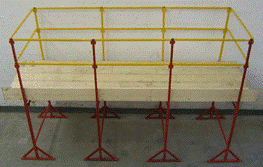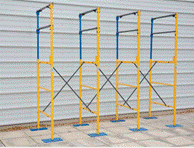
Patents for modular scaffolding system infringed, but registered designs held to be invalid
The case of Safestand v Weston Homes [2023] EWHC 3250 (Pat) concerned registered design and patent rights in builders’ trestles, specifically, safety features of modular scaffolding systems.
Background
Safestand designs and sells a market-leading modular scaffolding system for low level access platforms (intended to be a solution to working at height in construction). Safestand brought a claim against Weston alleging that Weston’s ‘Kwik Kage’ system infringed three of Safestand’s patents, and three of its re-registered designs (“RRDs”) . (The designs were originally registered as Community registered designs.)
Weston counterclaimed for invalidity of (i) two of the patents (“EP 738” and “UK 822”), for obviousness; and (ii) all three RRDs, based on lack of unity and/or clarity, and lack of individual character.
Safestead designs

Weston’s Kwik Kage system

Rights relied upon
Safestand relied upon three patents in its claim against Weston:
- UK 978, which claimed handrails for joining trestles at variable spacing, and an ‘anti-flip’ bracket to support overhanging portions of the platform.
- EP 738, which claimed an additional safety barrier for the same modular system as UK 978.
- UK 822, which claimed a bracket for holding a ‘kick-board’ (low-level skirting to prevent a user stepping off the platform).
The representations of the RRDs all showed the same modular system described in the patents.
Patents
Validity
In his judgment, Hacon J (sitting as a High Court judge), found all three of Safestand’s patents valid. Weston failed to show EP 738 was obvious over prior art “Berchem”. The judge outlined that when considering prior art for the purposes of obviousness, the focus should be on what the prior art discloses and what it does not disclose, rather than gauging its interest to the skilled person and assessing its merits as a starting point from which to arrive at the invention.
The judge did not accept that any of the steps taken cumulatively from Berchem to get to the patented invention would be obvious, and not even that some of them individually were obvious. The judge did not think it would have occurred to the skilled person that there was any point to a safety barrier on the working side, which enabled walls and other structures to be built in fewer lifts, and was included within EP 738. This inclusion of a selectively removable safety barrier on the working side also rendered EP 738 inventive over prior art “Kelk”.
As to UK 822, the skilled person would not have thought to adapt “Dobersch” nor “Harris” in a way which resulted in the patented bracket.
Infringement
Hacon J also held the patents were infringed by Weston’s trestle systems. Weston’s primary defence on infringement was the argument that their system did not include any ‘trestles’ because the supporting structures in their Kwik Kage system were too unstable to be a trestle if used without cross-braces.
Weston attempted to rely on lengthy and extensive experiments to establish the stability of their system, which were the subject of an interim application by Safeguard who successfully achieved a waiver of privilege in the results of related experiments. The judge ultimately agreed with Safeguard that the experiments were irrelevant in resolving any relevant issues between the parties.
The judge held that the skilled person would not qualify the standard definition of a trestle with an imprecise requirement that it not be ‘too wobbly’ in use – the trestles were found to be trestles as they accorded with the relevant British Standard. As Hacon J concluded, “[a]n unsatisfactory trestle is still a trestle”.
Registered designs
The judge held that none of Safestand’s RRDs were valid. All sought to protect multiple alternative embodiments (the anti-flip bracket may be red or green, the ladder holder extension may be present or absent and the kickboard brackets may be optional or in red or green), and therefore none was a ‘design’ for the purposes of the Registered Designs Act 1949.
Each design application should be in respect of a single design and no single design was claimed for by any of the RRDs in suit.
Key takeaway
The case is a useful reminder that infringement claims of related patents and registered design rights do not fall or succeed together and it’s possibly that one type of registration might be valid and infringed even if the other is not. By having both forms of protection, product designers give themselves the best possible chance of protecting their inventions.








